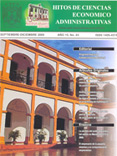ANÁLISIS ECONÓMICO DE UNA PLANTACIÓN COMERCIAL DE MELINA AFECTADA POR DIABRÓTICA EN EL MUNICIPIO DE HUIMANGUILLO, TABASCO
DOI:
https://doi.org/10.19136/hitos.a0n43.944Palabras clave:
Beneficio-costo. Costos de producción. Diabrótica. Insecto-plaga. Melina.Resumen
RESUMEN: Objetivos: 1) Analizar la relación beneficio/costo por afectaciones de una plaga en plantaciones de forestales de melina. 2) Identificar un método para reducir los costos de producción en plantaciones comerciales de melina afectadas con plaga diabrótica. Material y método: Para el análisis técnico se visitaron las plantaciones de productores, en los municipios de Huimanguillo, Emiliano Zapata y Balancán, en el Estado de Tabasco, con indicios del insecto-plaga, para plantear la estrategia apropiada para el desarrollo del proyecto, considerando: 1. La superficie establecida 2. Edad de la plantación 3. Determinación de las unidades de muestreo. 4. Tamaño del daño 5. Identificación y clasificación taxonómica del agente causal. Con la información encontrada, se determinó: Las afectaciones relacionadas con la producción primaria, ya sea madera o polines. Se trabajó en una superficie de 100 hectáreas establecidas de melina, con lotes de 3 meses a 2 años de edad. Se tomaron muestras de insectos, Utilizando las claves taxonómicas de Konstantinov, A.S. & N.J. Vandenberg (2006). El análisis económico en una hectárea de producción se basó en la metodología realizada por SEDAFOP (2006), se calculo la relación beneficio-costo considerando la regla de decisión financiera, con valor = 1. Resultados: No se presenta afectación significativa por la plaga y hasta ahora se ha combatido a tiempo con insecticidas que no constituyen costos adicionales de importancia (están considerados en el paquete tecnológico) que tengan impacto en la rentabilidad encontrada en la plantación. Conclusión: El estudio técnico revela que, existen alrededor de seis especies de este insecto-plaga defoliadoras en melina en México; pero hasta ahora han sido poco estudiadas, se desconoce su biología y consecuentemente su impacto en plantaciones de melina. La plantación comercial de melina que fue objeto de estudio no presenta afectación significativa por la plaga y hasta ahora se ha combatido a tiempo con insecticidas que no constituyen costos adicionales de importancia. La rentabilidad estimada demuestra excelentes ganancias, y se deben incentivar este tipo de agronegocios. ABSTRACT: Objectives: 1) Analyze the benefit/cost relationship by affectation of a plague in the forest plantations of melina. 2) Identify a method to reduce the production costs in the commercial plantations of Melina affected by plagues of diabrotica. Material and method: For the technical analysis several plantations indicating to have the insect-pest, were visited in the municipalities of Huimanguillo, Emiliano Zapata and Balancan in the state of Tabasco, in order to propose the best strategy to develop the project, considering: 1. The established surface. 2. The age of the plantation. 3. The determination of the sampling units. 4. The amount of the damage. 5. The identification and taxonomical classification of the causal agent. Once the findings were done, it was determined that: The affectations were related to the primary production, wood or skids. The works were done in an established surface of 100 hectares of melina, with three-month to two year-old allotments. Samples of the insects were gathered, using the taxonomical codes of Konstantinov, A.S. & N. J. Vandeberg (2006). The economical analysis of an hectare of production was based on the methodology followed by SEDAFOP (2006). The benefit/cost relationship was calculated, considering the financial decision rule, with a value = 1. Results: There is no meaningful affectation by the pest and up to now it has been attacked on time with insecticides that do not represent important additional costs (they are considered in the technological package) that may represent an impact in the profitableness found in the plantation. Conclusion: The technical study reveals that there are about six species of this melina defoliator insectpest in Mexico, but hitherto, they have not been really studied; their biology is unknown, and so is their impact on the plantations of melina. The commercial plantation of melina object of this research, doesn’t present any meaningful affectation by the plague, and up to now it has been attacked on time with pesticides that do not represent any important additional cost. The estimated profitableness show excellent revenues, so these kinds of agro-businesses must be incentivized.Descargas
Descargas
Publicado
Número
Sección
Licencia
Como requisito del manuscrito, se solicita al autor la Carta de cesión de derechos de autor, a nombre de la Universidad Juárez Autónoma de Tabasco en su calidad de casa editorial, para que la Revista tenga los derechos de publicación y evitar plagios.
POLÍTICAS DE PLAGIO
El Consejo Editorial de la Revista HITOS DE CIENCIAS ECONÓMICO ADMINISTRATIVAS tiene la autoridad de rechazar, en el proceso de revisión, todo manuscrito que no tenga la citación adecuada en los documentos consultados en su trabajo de investigación científica, lo cual puede considerarse como conductas de plagio. Asimismo, los dictaminadores realizan la revisión de plagio mediante software especializado como iThenticate, entre otros.
POLÍTICAS DE DERECHOS DE AUTOR
Los autores que tengan publicaciones en la Revista, aceptan los siguientes términos:
• En el momento que el manuscrito sea aceptado, el autor cede los derechos de autor a la Universidad Juárez Autónoma de Tabasco (UJAT), casa editora de la Revista Hitos de Ciencias Econ´´omico Administrativas.
•Los autores podrán realizar acuerdos adicionales de distribución no exclusiva de la versión del artículo publicado (p. ej.: incluirla en un repositorio institucional o publicarlo en un libro), siempre que se indique la publicación inicial en esta revista.
• Se permite y recomienda a los autores publicar su trabajo de investigación en Internet (p. ej.: archivos institucionales o personales) lo que permitiría intercambios de mayor beneficio para aumentar la citación de la obra publicada.





